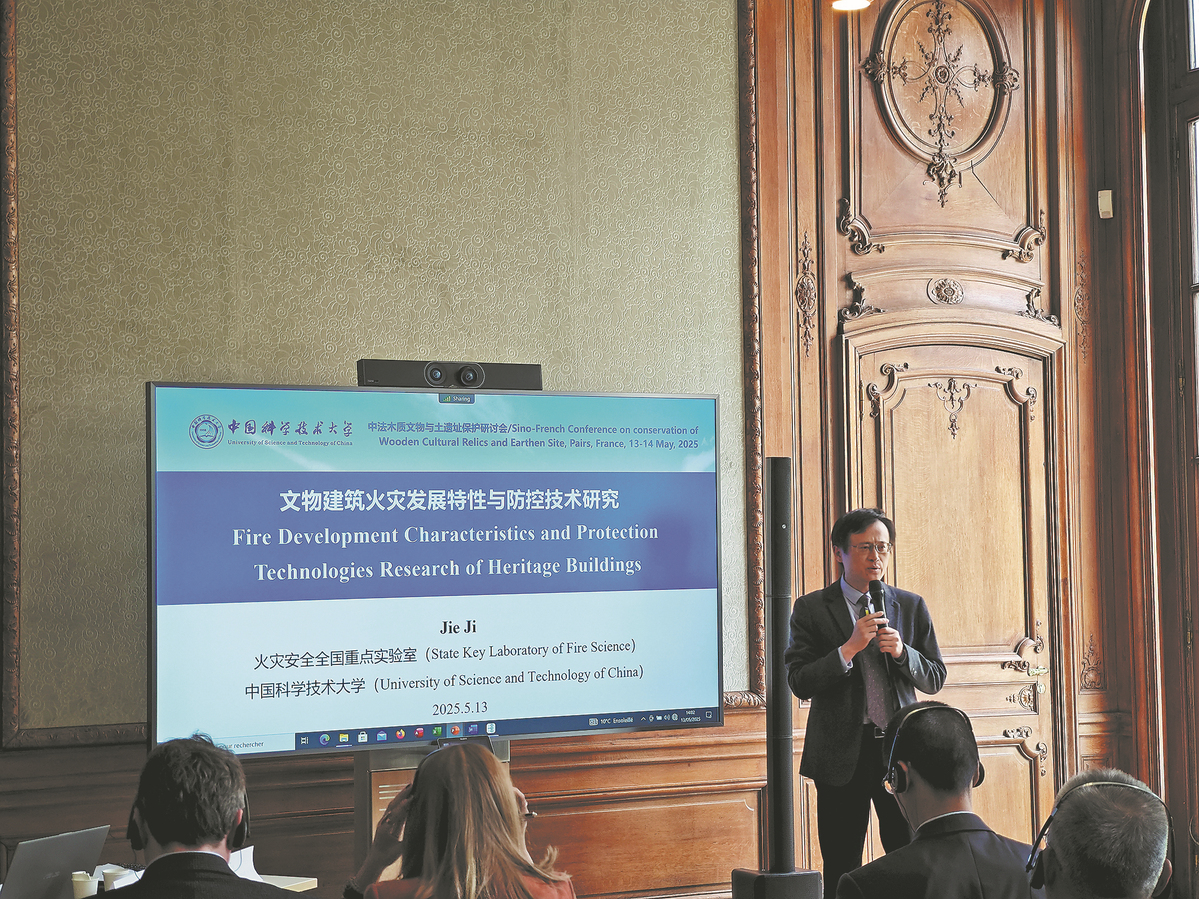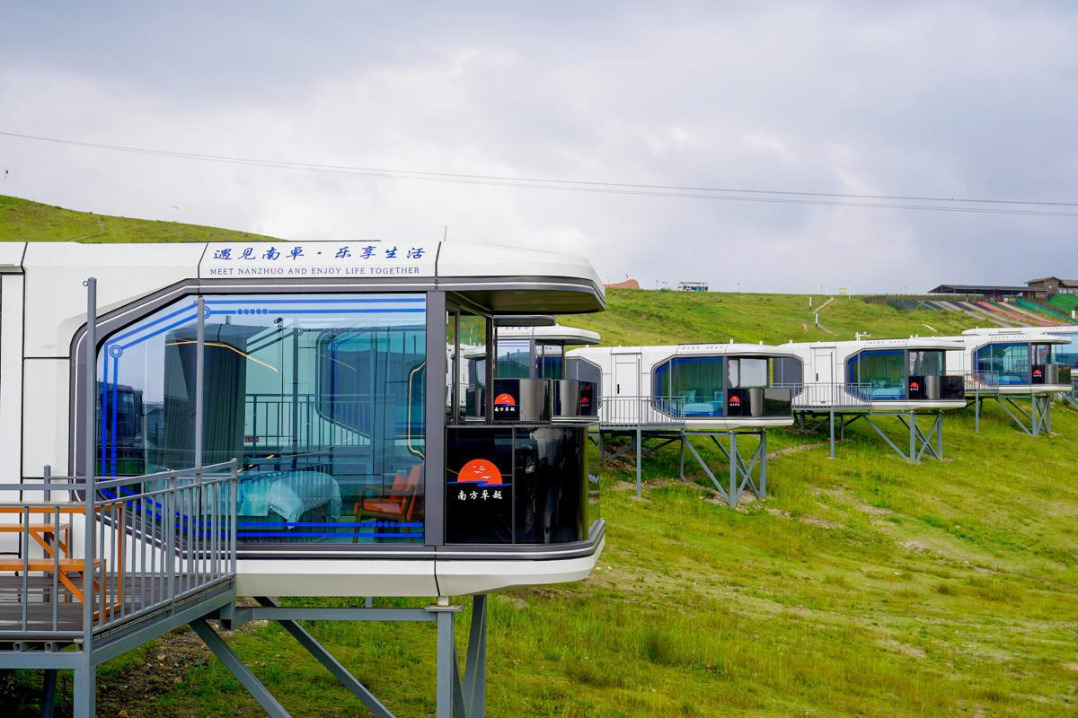Researcher fights fire, saves cultural relics


In the Sino-French Conference on Conservation of Wooden Cultural Relics and Earthen Sites, held in Paris from May 13 to 14, Chinese fire scientist Ji Jie gave a speech titled "Fire development characteristics and protection technologies for wooden heritage buildings".
The reopening of the burnt Notre-Dame de Paris at the end of last year brought relief to Ji, a professor and deputy director at the State Key Laboratory of Fire Science at the University of Science and Technology of China, based in Hefei, capital of Anhui province.
"The fire on April 15, 2019, shocked the world, and the whole of France was in tears," Ji said, adding that there have been many other fires that have pained him as well.
In May 2024, the Emperor Qinshihuang's Mausoleum Site Museum in Xi'an, Shanxi province, partnered with the Fondation des Sciences du Patrimoine for wooden heritage and earth site protection. Ji's team focused on fire spread mechanisms and prevention. They studied wood combustion, which is crucial for various heritage buildings such as tombs, palaces and temples. "Different wood types and conditions impact ignition and burning characteristics, requiring detailed analysis," Ji said.
Fire experiment
Over the past years, Ji and his team have visited nearly 100 cultural heritage sites in the country, conducted numerous experiments and led a national research and development program on fire risk in heritage buildings.
Sometimes, they need to simulate fire scenarios in real houses.
In August 2023, Ji's team conducted a full-scale wooden structure building fire experiment in Xidi, an ancient village in Huangshan, Anhui.
"Our requirements for an experimental building are very strict, so it's not easy to find such a building," Ji said.
The building needs to have the same structural characteristics as a typical heritage one.
For safety reasons, the building should not be too close to other buildings, have a water source nearby and wide enough roads for fire trucks to pass through, as the fire needs to be extinguished after the experiment.
Finally, they found a building in Huangshan that was several decades old and no longer suitable for living. The owner had renovated the house, but Ji's team needed to restore it for the experiment.
They engaged a professional ancient building restoration company, providing detailed requirements for restoring features like mortise and tenon structures and cracks typical of ancient buildings.
"The experiment was highly successful," Ji said. "Through this experiment, we have gained deeper insights into the spread mechanism of early fires in old buildings."
Risk assessment
Their findings were used to create educational materials and the Fire Drill Guide for National Cultural Heritage.
This guide, issued by the National Cultural Heritage Administration last year, includes fire scenarios, precautions and instructions for drills in cultural heritage units nationwide. According to the guide, conventional heritage buildings undergo risk assessments once a year or every few years, similar to an annual physical check-up for a person.
Ji's team proposed a dynamic fire risk assessment method that considers the various risks affected by peak tourism seasons, repair work and so on, as well as the balance between fire hazards and fire prevention capacities of heritage buildings, which are significantly different from modern buildings.
Recognizing the prevalence of electrical fires as a significant risk factor in both modern and heritage buildings, Ji's team has also developed an anti-interference early warning system to detect and mitigate electrical fire hazards.
By addressing potential sources of interference that can trigger false alarms, such as electrical appliances and environmental factors, this system enhances the reliability of fire detection in heritage buildings. An unmanned aerial vehicle inspection system with fire recognition algorithms was also developed for enhanced fire monitoring.
These technologies were integrated into a comprehensive fire prevention and control platform.
Ji also led research on coordinated ground-air firefighting for forest and grassland fires.
Prescribed burning as a preventive measure and cooperation with forestry departments were key aspects of their work, he said.
For example, burning the grass in a valley between two mountains acts as a natural firebreak. In northern forest areas, forestry departments need to plan and burn combustible materials in the wild before snowfall or melting of ice and snow.
"After burning, it becomes a natural firebreak," Ji said.
They have cooperated with local forestry departments to conduct prescribed burning fire spread experiments with an area of up to 100,000 square meters.
"Through the cooperation, the forestry departments completed their tasks, and we got the data we needed," said Ji, adding that research cannot be stopped at the experimental level alone.
Popularizing knowledge
Ji emphasized the importance of transforming research outcomes into practical products for widespread education on fire safety. He initiated fire knowledge popularization efforts in 2017, aiming to educate people at all levels, including security guards.
He also served as the deputy director and secretary-general of the Popular Science & Public Education Committee of China Fire Protection Association, conducting popular science activities nationwide. He frequently travels around the country to give lectures and teach professional firefighters within the national and provincial-level cultural heritage administration system.
"I believe that popularizing fire extinguishing knowledge for heritage buildings is crucial," Ji said.
He found that existing popular science books on fires either focused on evacuation or were too academic, lacking in appeal. He thus felt the need to publish a more suitable popular science book. In 2024, he co-authored a popular science book, targeting children from grades three to nine.
This book creatively combines heritage knowledge, historical stories and poetry to spread scientific fire knowledge through an adventurous story featuring a fiery sprite named Huo Tuantuan.
zhulixin@chinadaily.com.cn





































